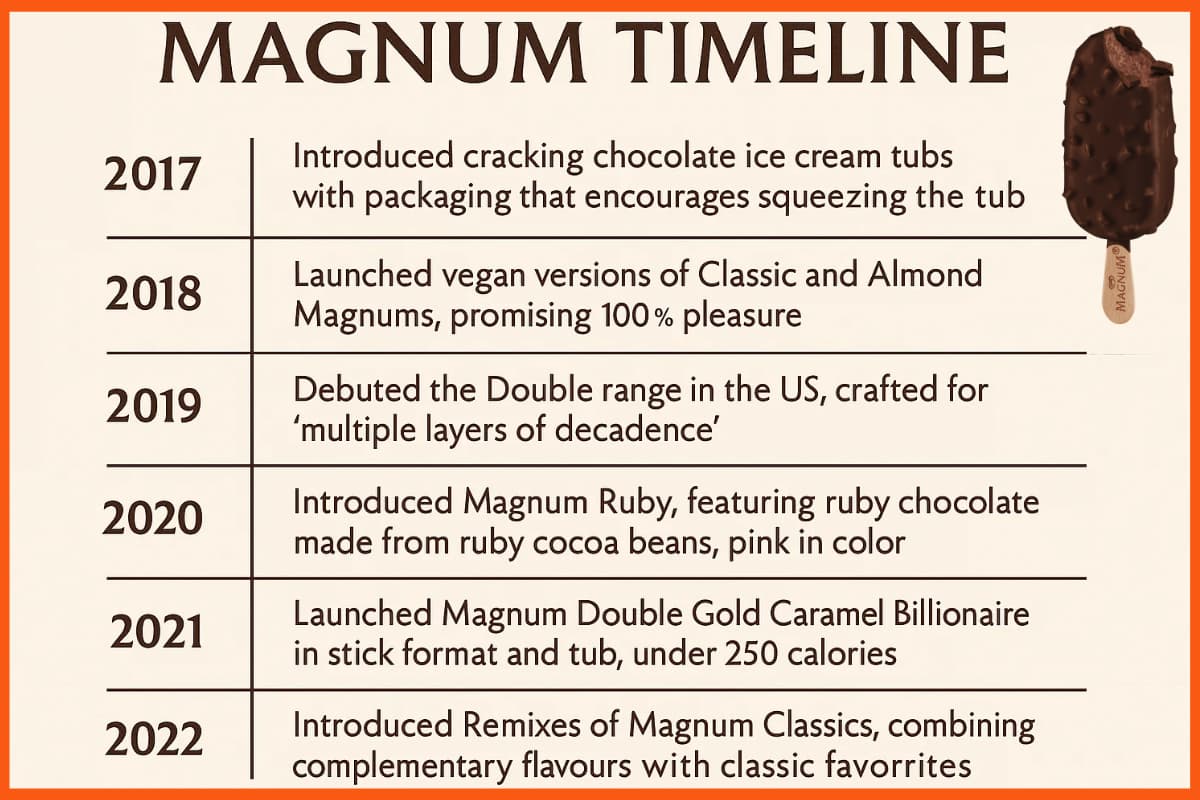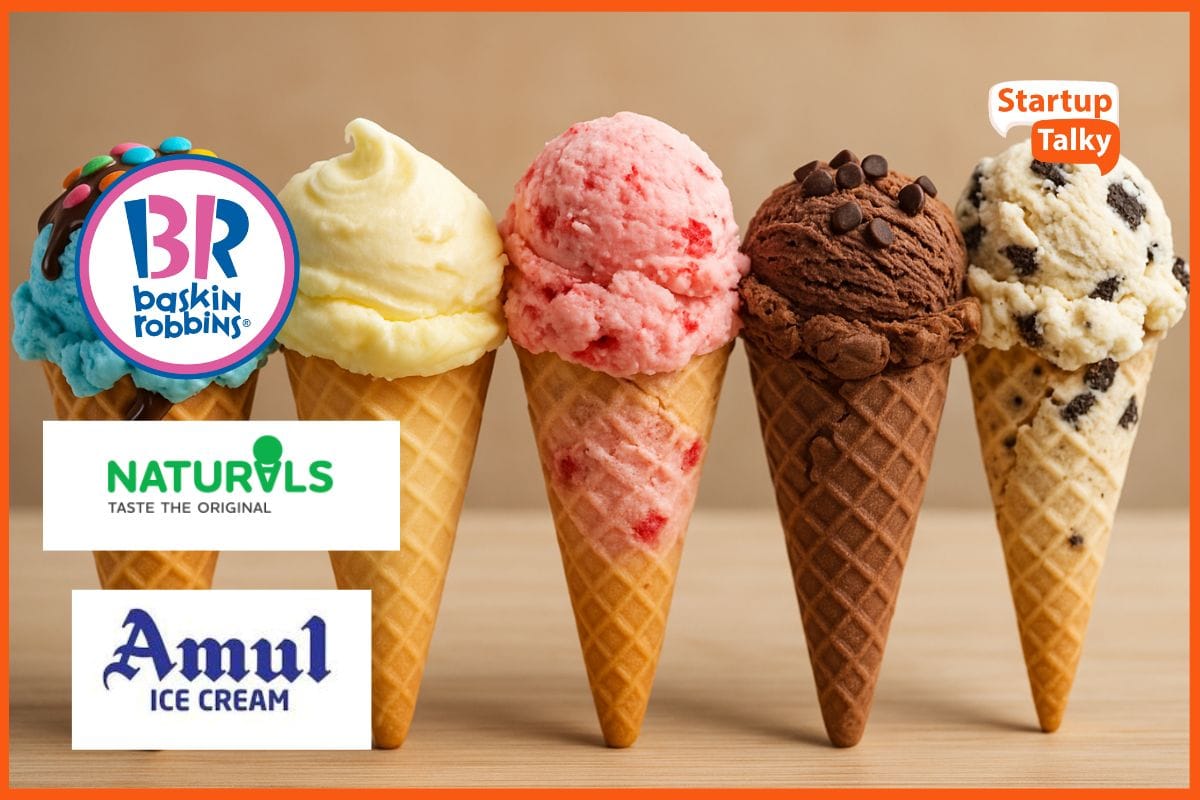Brands like Magnum become instant favorites of people. The credit goes to the public relations team that works behind the scenes and creates mind-boggling marketing strategies and advertisements. These help the brand build its place in the market. And for Magnum, it’s Unilever that is responsible for the media spend spanning across TV, outdoor, digital, and PR mediums. Today, Magnum is a leading global brand, selling 1 billion units annually, making it the largest of Unilever’s ice cream brands.
FMCG Giant Unilever has also expanded its distribution from its stronghold of Europe to the US and China. Its popularity in India is only increasing with each passing day. The company’s marketing strategy makes it a formidable competitor, lures people into trying Magnum Ice Cream, markets the ice cream as an adult indulgence brand with a touch of sex appeal, and communicates the royal theme of the brand.
About Magnum
Magnum Target Audience
Magnum Brand Positioning
Magnum Marketing Strategy
Magnum SWOT Analysis
Magnum Inbound Strategy
Magnum Outbound Strategy
Magnum Mobile Campaigns
Magnum Social Media for Marketing Campaign
About Magnum
Magnum Ice Cream was developed in Belgium at the Ola laboratory in cooperation with the Belgian chocolate producer Callebaut. It was released in Germany in the year 1989 as an upmarket/luxury ice cream for the Nogger brand. Magnum is now owned by the British/Dutch company Unilever. The company also has a strong social media presence via Instagram, Facebook, and YouTube.
Magnum Ice Cream has emphasized its dominance by coming up with highly imaginative flavor combinations, fancy packaging, and limited-edition promotions. With the help of Magnum, Unilever remains an innovator responsible for single-handedly pushing forward the variety of extravagant confectionery blends that can be successfully packaged as an ice-cream stick.
The company began testing a dairy-free vegan version of ice cream in selected markets (including New Zealand and Sweden) in 2019. Magnum wasn’t popular in the United States, but with the changes in the premium ice cream sector in the country in recent years, partly because of Nestle’s Häagen-Dazs ice cream bars, it is gaining traction. Magnum was launched in the US in 2011.

Magnum Target Audience
Magnum’s target audience belongs to the 14-45-year age group. It has loyal customers who prefer premium ice cream. The target market of Magnum is the upper niche class. The company focuses on people who wouldn’t mind spending a bit more on ice cream to indulge in supreme quality eatables. These people are willing to spend on style, quality, brand value, status, etc.
The global sales figure of Magnum was $2.54 billion in 2015,45-year which was an increase of 8% from the year before. Unilever strives to maintain its edge in most markets by positioning Magnum as an affordable luxury treat for adults. The segmentation of Magnum’s target audience is done on the basis of income, social status, economic class, and esteem level.
Magnum Ice Cream’s marketing strategy focuses on the smaller but elite segment of society. Magnum takes into consideration the needs and the benefits of customers, which are useful for identifying market opportunities and developing value propositions.

Magnum Brand Positioning
Positioning is extremely important for the brand when it tries to build an image in the minds of its customers. It involves parameters that differentiate the product from the competitors in the same category. Positioning means how consumers rate Magnum in comparison to other ice cream brands such as Amul, Baskin-Robbins, and Mother Dairy. They also happen to be the main competitors of Magnum.
Magnum’s positioning strategy can only be sustained if it continues to deliver the promised consumer value. The quality and price positioning state that higher prices for higher quality. Magnum’s positioning appeals to stylish people and the customers who associate a premium brand with priceless quality.
Magnum Ice Cream Innovations Timeline (2017-2022)

| Year | Innovation |
|---|---|
| 2017 | Introduced cracking chocolate ice cream tubs with packaging that encourages squeezing the tub. |
| 2018 | Launched vegan versions of Classic and Almond Magnums, promising 100% pleasure. |
| 2019 | Debuted the Double range in the US, crafted for ‘multiple layers of decadence’. |
| 2020 | Introduced Magnum Ruby, featuring ruby chocolate made from ruby cocoa beans, pink in color. |
| 2021 | Launched Magnum Double Gold Caramel Billionaire in stick format and tub, under 250 calories. |
| 2022 | Introduced Remixes of Magnum Classics, combining complementary flavors with classic favorites. |
Magnum Marketing Strategy

Promotion of Ice-Cream Sticks in an Appealing Way
Magnum ice-cream sticks are marketed as luxurious indulgences, highlighting their rich flavors and premium ingredients. The brand uses visually stunning advertisements and engaging social media content to create a sense of sophistication and pleasure.
Promotion of the Dairy-Free Vegan Variety of the Ice Cream
Magnum promotes its dairy-free vegan options through targeted campaigns that emphasize their delicious taste and creamy texture. Highlighting sustainable, high-quality ingredients, these campaigns appeal to both vegan consumers and those reducing dairy intake.
Focusing on the Smaller, Elite Section of Society
Magnum targets a smaller, elite section of society by positioning itself as a luxury brand. This focus on high-end lifestyles and premium experiences appeals to consumers who value quality and exclusivity.
Clever Segmentation of the Market
Magnum uses clever market segmentation to cater to diverse consumer needs, targeting groups like young professionals, health-conscious individuals, and luxury seekers. Tailored messaging ensures the brand resonates with a wide audience.
The Interesting & Engaging Magnum Pleasure Test
The Magnum Pleasure Test invites consumers to discover their perfect Magnum flavor through a fun, personalized test. This interactive campaign deepens consumer engagement and promotes product variety.
Mobile Ad Campaign
Magnum’s mobile ad campaigns utilize rich media ads, interactive content, and location-based targeting to reach consumers on the go. This approach ensures high engagement rates and boosts brand awareness.
Experiential Marketing
Magnum brings its luxury image to life through experiential marketing like the Magnum Pleasure Store pop-ups. These stylish spaces turn buying ice cream into a premium experience where customers can taste, explore, and share on social media. With carefully chosen lights, music, and scents, the brand creates a full sensory environment that makes ice cream feel like a luxury treat. This not only excites people in the moment but also builds lasting loyalty to the brand.
Promotion of Magnum’s Limited Ice Cream Variants
Magnum creates excitement with limited-edition ice cream variants, encouraging quick purchases before they disappear. These promotions feature innovative flavors and premium ingredients, strengthening the brand’s luxury image.
Twitter Campaigns with Audience Participation
Magnum’s Twitter campaigns encourage user participation through contests, branded hashtags, and sharing Magnum moments. This strategy increases brand visibility and builds a loyal online community.
Celebrity Endorsements

Collaborating with celebrities like Kareena Kapoor Khan enhances Magnum’s brand appeal and reach. She has been roped in to urge consumers to get #LostinPleasure through a selfie campaign. The month-long contest is asking people to send in their selfies with a Magnum Ice Cream stick in hand, and a creative reason why Magnum gets them lost in pleasure. Recently, Jennifer Winget endorsed Magnum in 2024. Celebrity endorsements add glamour and credibility, attracting fans and boosting brand recognition.
Magnum SWOT Analysis
The SWOT analysis of Magnum offers a clear view of the brand’s overall market position, helping to understand the internal and external factors that influence its growth, challenges, and long-term opportunities.

Magnum Strengths
- Use of the finest ingredients
- Position as the first luxury ice cream brand
- Adult-focused marketing
- Exquisite packaging
Magnum Weaknesses
- Limited awareness in the US market
- Concerns about nutrition labeling
- High costs
- Competition from Trojan Magnums
Magnum Opportunities
- Expanding flavor variety
- Increasing vendor partnerships
- Leveraging a year-round market
Magnum Threats
- FDA regulations
- Rise of health-conscious consumers
- Strong competitors

Magnum Inbound Strategy
When Magnum was launched in India in February 2014, the Magnum Pleasure Patrol was an activation executed as part of the launch. Over 2000 people across Mumbai and Pune got to taste Magnum ice cream samples from 22nd February to 24th February 2014. A luxury vehicle visited gourmet cafes, malls, and high-traffic areas with an emcee and a camera crew, capturing people’s reactions after their first bite of Magnum’s ice cream.
There was another campaign in which people offered their idea of pleasure, be it a day at the spa or unlimited shopping. They were put through the Magnum Pleasure test that required them to choose between Magnum and their idea of pleasure after having tasted some ice cream. Understandably, all resistance failed while Magnum scored on the test.
Magnum Outbound Strategy
Magnum’s marketing success is heavily reliant on its outbound strategy, which is evident through its ATL activities and out-of-home campaigns. Since the brand connects with well-traveled people, it is present in Europe, North America, Asia, and Australia. For outbound marketing, Magnum conducts hyper-local activities that can be measured in sales. One such instance is the product launch spike in areas with high footfall.
Magnum Mobile Campaigns
The Magnum marketing team came up with a rich media mobile ad campaign that would allow users to tweet from within the mobile ad directly. The mobile ad campaign was part of an all-encompassing marketing strategy that included both Above the Line (ATL) and Below the Line (BTL) executions.
This ad campaign provided Magnum with a platform to quickly reach a large user base and create awareness. It also got people talking about Magnum through Tweets and pictures, and maximized their participation in the Twitter contest.
Magnum Social Media for Marketing Campaign
Magnum came up with a two-phase marketing campaign strategy that promoted the product to the masses in a controlled manner. The first phase offered exclusivity. To prioritize the distribution of the product, the brand asked people to Tweet for limited Magnum Infinity ice creams to be distributed in their city.
The city with the most Tweets got to try the limited Magnum Infinity first. By doing this, each Tweet represented a chance for a person residing in some city to try the product before everyone else. To sustain excitement and drive sales, Magnum launched the second phase of the campaign, where the consumer’s Tweet earned him or her a chance to go on a trip to London. The person who collected the most points won. One could either Tweet or put up a unique code on Twitter to participate.
By providing consumers with an interface to Tweet within the ad, the campaign got them talking about the brand and their experience with Magnum Infinity. It helped Magnum connect with the intended audience and generated a buzz among people about Magnum Infinity. The campaign also ensured continuous user engagement and increased the brand recall.
#NotAvailableInTheMetaverse Magnum Campaign
This campaign of Unilever for Magnum ice cream launches VR goggles to encourage consumers to indulge in real-life pleasure, highlighting that some sensations can’t be replicated virtually.
FAQs
Who is the brand ambassador of Magnum?
Kareena Kapoor Khan is Magnum’s Brand Ambassador.
What is Magnum’s Pricing Strategy?
The quality and price positioning of Magnum state higher price for higher quality. Magnum’s positioning appeals to stylish people and the customers that associate a premium brand with priceless quality.
What is Magnum’s target market?
Magnum’s target audience belongs to the 14-45 years age group. It has loyal customers who prefer premium ice cream. The target market of Magnum is the upper niche class.
Who owns Magnum?
Magnum is now owned by the British/Dutch company Unilever.
What is Magnum USP?
Magnum unique selling point is a Luxury ice cream experience with rich taste, premium ingredients, and indulgent lifestyle appeal.
What are Magnum ice cream strengths and weaknesses?
Magnum’s strengths lie in its use of the finest ingredients, its position as the first luxury ice cream brand, its adult-focused marketing, and its elegant packaging. However, it also faces weaknesses such as limited awareness in the US market, concerns over nutrition labeling, high product costs, and brand confusion due to competition from Trojan Magnums.


























